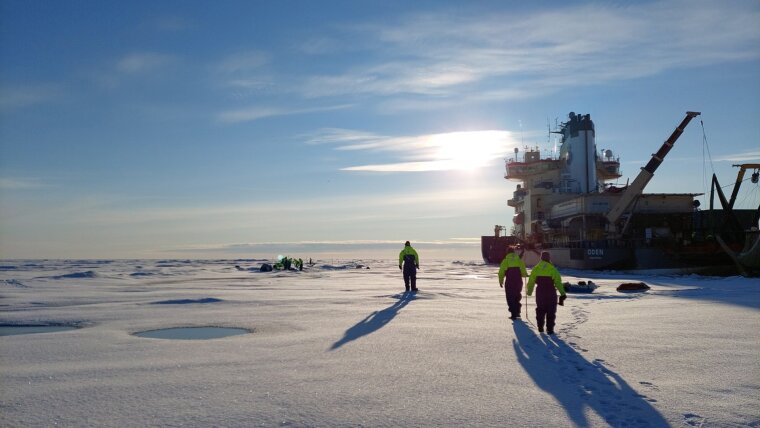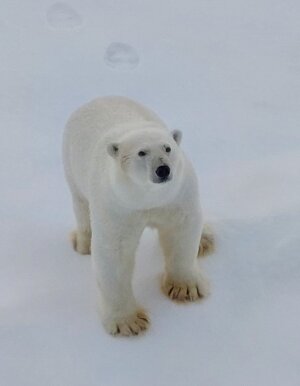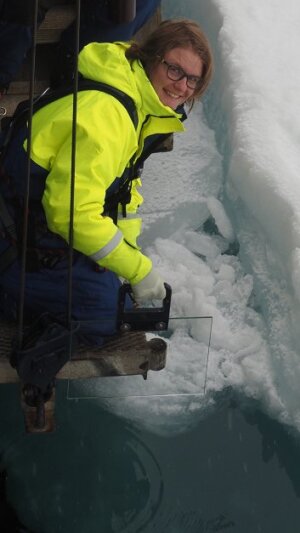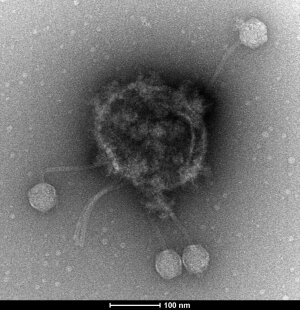
The North Pole is a deeply inhospitable place. Covered with ice and snow, it exhibits extreme temperatures and daylight conditions. Months of darkness in winter are followed by perpetual daylight in summer. And yet, even in these harsh conditions, microbial life thrives. Marine biologist Dr Janina Rahlff researches how viruses and bacteria not only survive in this setting but also contribute to a stable ecosystem.
A polar bear in the Arctic
Image: Janina RahlffBy Ute Schönfelder
In the summer of 2021, Janina Rahlff was part of an international research team that boarded the Swedish icebreaker »Oden« for a two-month expedition to the Arctic, aiming to catalogue polar life. Besides encounters with polar bears, walruses and seals, the researchers were focused above all on the organisms and viruses that live in the surface microlayer between the air and water. »Although just one millimetre thick, the surface film on top of the water is home to numerous microorganisms and viruses that we still know relatively little about, despite their importance for ecological processes in this habitat, « says Rahlff.
The marine biologist is interested in the smallest of the small: viruses—or, more precisely, bacteriophages and their hosts. During the long journey from Helsingborg in Sweden to the North Pole and via Northern Greenland on the return voyage, traversing over 3,000 kilometres in total, she took samples directly from the surface of the water along with comparative samples from depths of roughly 60 centimetres and from a meltwater pool on the surface of the ice. »We wanted to find out which viruses and bacteria actually persist here and how they manage to cope with the extreme Arctic conditions.«
Marine biologist Janina Rahlff collects water samples from aboard the ship
Image: Maria SamuelssonViruses between the air and water
Janina Rahlff and her team collected the water samples using a glass plate sampler. They submerged the glass plate in the water, which caused the surface film to adhere to the plate, before carefully skimming it off and collecting it. The water samples were processed on board and deep-frozen to –80 °C for later laboratory analysis.
Janina Rahlff initially worked on this research in Kalmar, Sweden. About a year ago, she started to lead the »Aero-Aquatic Virus Research« group at the University of Jena. Last autumn, she published the results together with colleagues from the Linnaeus University in Kalmar, Sweden and the University of York, UK in »Microbiome«.
»Some things still surprised us,« admits Rahlff. After extracting and analysing DNA from the collected water samples, the researchers gained an overview of the microbial and viral communities.
»The meltwater pool on the surface of the ice featured a considerably less diverse viral community than the upper centimeters of the ocean,« explains Janina Rahlff, outlining one of the study’s central findings. This could be due to the lower numbers of host organisms in the meltwater pool, which the viruses require to proliferate. In light of rising temperatures in the Arctic caused by the advancement of climate change, Rahlff says, increasingly large areas of ice will be covered by meltwater. »We can expect this to have a significant impact on the microbial ecosystem.«
Image of the bacterium Leeuwenhoekiella aequorea with four attached viral particles, taken at 68,000x magnification
Image: Maria Chechik, University of YorkIn their analysis, the team was also able to demonstrate how viruses in the surface microlayer between the air and water manage to withstand the extreme Arctic cold. For one, they often enter a state of »dormancy« surviving within the genome of their host. For another, the viruses also possess special cryoprotective genes that can potentially preserve both themselves and their host cell against freezing—using a »molecular antifreeze«.
That, Janina Rahlff emphasizes, suggests that viruses play a vital role in stabilizing Arctic microbial ecosystems, which in turn has implications for the broader food web and the carbon cycle.
Another insight arising from the study is the overall importance of the surface microlayer between the air and water, which seems to serve as a platform for viruses to spread, because the team found virus genomes in surface film samples at various other sampling locations across the Arctic. »Starting from the uppermost layer of water, aerosol formation facilitates the entry of viruses into the atmosphere, allowing them to spread across large distances.« Whether the film serves as a platform for viral spread in the Arctic alone, or also in other oceans of the world, will require further research.
Original publication:
Surface microlayer-mediated virome dissemination in the Central Arctic, Microbiome 12/218, 2024; https://doi.org/10.1186/s40168-024-01902-0External link


